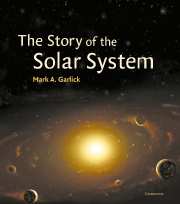Book contents
- Frontmatter
- Contents
- Miscellaneous Frontmatter
- Introduction
- Part 1 Genesis of the Sun and Solar Nebula
- Part 2 Emergence of the Sun's Family
- Part 3 Solar System Past and Present
- Part 4 End of an Era
- Present-day–10 900 million years: Main Sequence
- 10 900–11 600 million years: Subgiant Phase
- 11 600–12 233 million years: Red Giant Phase
- 12 233–12 365 million years: Helium Burning and Second Red Giant Phase
- 12 365 million years: Planetary Nebula Phase
- 12 365 million years: White Dwarf
- Hundreds of billions of years: Black Dwarf
- Time unknown: End of an Era … Start of an Era
- Glossary
- Index
Present-day–10 900 million years: Main Sequence
from Part 4 - End of an Era
Published online by Cambridge University Press: 10 November 2009
- Frontmatter
- Contents
- Miscellaneous Frontmatter
- Introduction
- Part 1 Genesis of the Sun and Solar Nebula
- Part 2 Emergence of the Sun's Family
- Part 3 Solar System Past and Present
- Part 4 End of an Era
- Present-day–10 900 million years: Main Sequence
- 10 900–11 600 million years: Subgiant Phase
- 11 600–12 233 million years: Red Giant Phase
- 12 233–12 365 million years: Helium Burning and Second Red Giant Phase
- 12 365 million years: Planetary Nebula Phase
- 12 365 million years: White Dwarf
- Hundreds of billions of years: Black Dwarf
- Time unknown: End of an Era … Start of an Era
- Glossary
- Index
Summary
The Sun is already dying, in a sense. All the while our star burns hydrogen on the main sequence, its core becomes gradually more depleted in that element, and a helium ‘ash’ is left in its place. As the core adjusts itself to this steadily changing composition, the star's diameter and brightness both slowly increase. When the Sun took its first steps onto the main sequence it was only 90 per cent of its current radius and 60 or 70 per cent of its present luminosity. It is quite a bit warmer and larger now than it used to be. And that trend is not going to change.
The next billion years will see a hike in the Sun's luminosity by about 10 per cent. That may not sound like a cause for concern, but for the innermost planets the change will be overwhelming. And, for the Earth in particular, this slight escalation in luminosity will signal the beginning of the end of billions of years of evolution. With that much extra energy flowing away from the Sun, our planet's polar caps will start to melt and its oceans will begin to warm up. Slowly, they'll evaporate into the atmosphere. Too much water vapour, like carbon dioxide, has a serious effect on our planet's climate. The Sun's energy heats the surface, but the heat is partially trapped. Infrared radiation cannot travel through water vapour or carbon dioxide, because they absorb it. And so the planet steadily warms up. Today, Earth is about 32 Celsius warmer than it would be without its atmospheric blanket.
- Type
- Chapter
- Information
- The Story of the Solar System , pp. 128 - 129Publisher: Cambridge University PressPrint publication year: 2002



